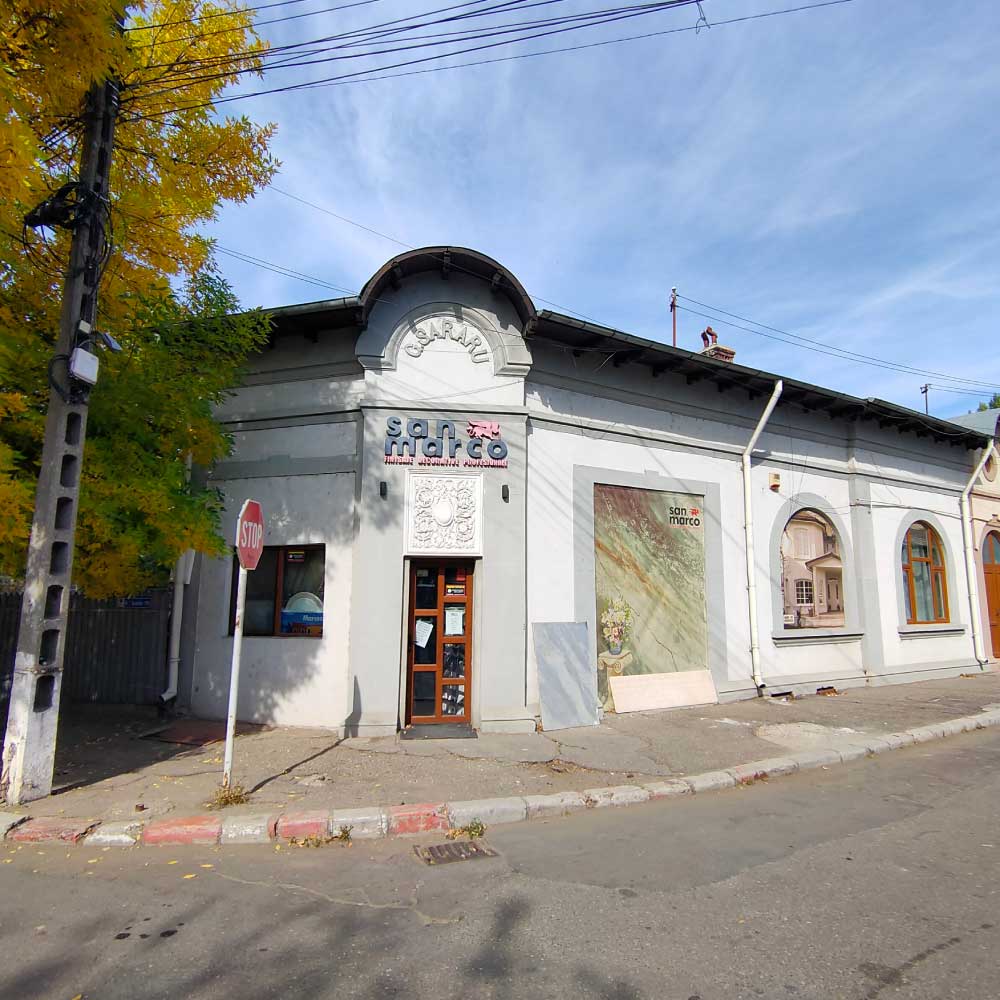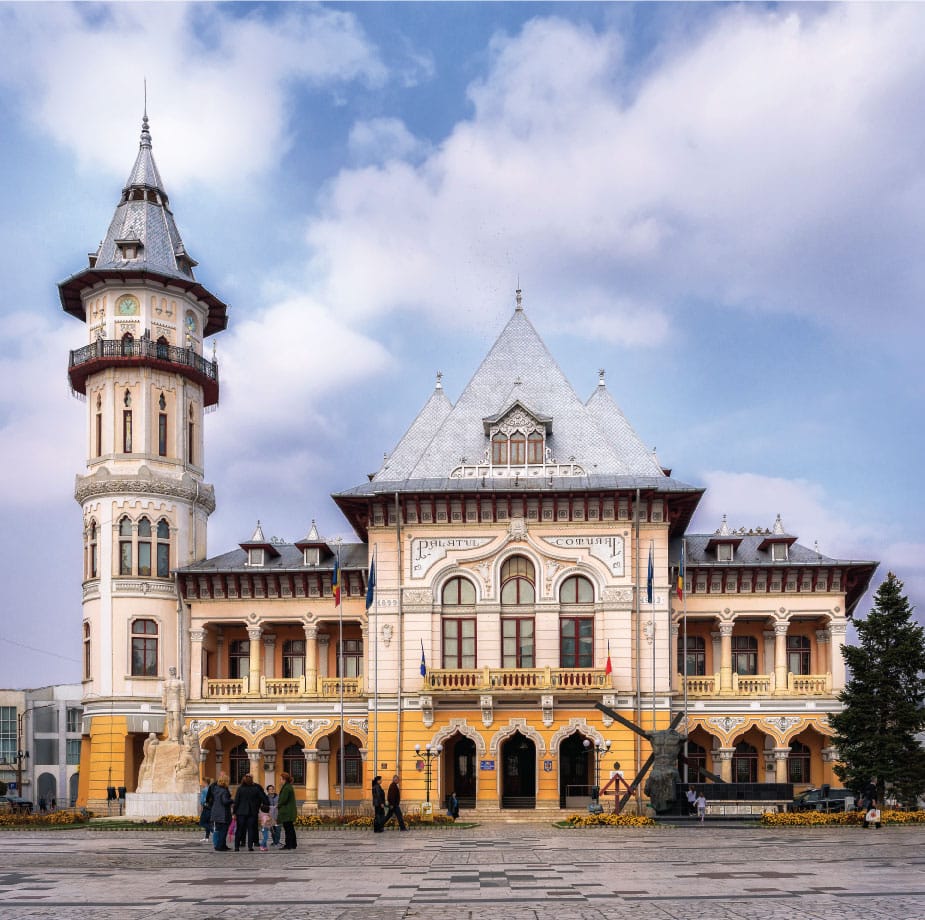
Casa George Săraru
noiembrie 7, 2022
Tribunalul Buzău
noiembrie 7, 2022Română
PALATUL COMUNAL BUZĂU ARHITECŢI ALEXANDRU SĂVULESCU ŞI SIEGFRIED KOFSINSKI (KOFSZYNSKI)
Hotărârea de a se construi un Palat al Primăriei Buzăului a fost luată în 1896, când primar al urbei era Nicu I. Constantinescu, unul dintre cei mai prolifici edili ai oraşului. Dorinţa buzoienilor a fost ca respectiva clădire să fie construită într-un stil caracteristic vechii arhitecturi româneşti. După ce arhitecţii Ion Mincu şi Louis Blanque au refuzat oferta de a proiecta clădirea, lucrarea a fost încredinţată arhitectului Alexandru Săvulescu, cel care mai avea la activ Palatul Poştei şi Telegrafului din Bucureşti (în prezent Muzeul Național de Istorie a României). Lucrările de construcție au fost demarate în decembrie 1899, materialele fiind procurate din județ sau din țară. Piatra pentru coloane și trepte a fost adusă din carierele de la Comănești, Câmpulung și cariera Saligny din Dobrogea, meșterii pietrari fiind italieni. Acoperișul a fost placat cu tablă de zinc și tablă plumbuită. La 13 noiembrie 1901, Alexandru Săvulescu a încetat din viață, lucrările fiind încredințate arhitectului polonez Siegfried Kofsinski (grafiat şi Kofszynski). Inscripția de pe frontispiciu – Palatul Comunal – a fost realizată pe marmură de Cararra de către sculptorul ploieștean Themistocle Vidali. Iată ce spunea Nicolae Iorga după ce a vizitat Buzăul și a văzut Palatul în construcție: „O pădure de stejari mărginaşă, un sălbatec crâng prăfuit s-a prefăcut în parc frumos cu multe alei şi largi perspective, cu chioşcuri şi statui. În capăt se vede, alcătuind astăzi mijlocul precis al oraşului, noua primărie cu un turn înalt, o lungă faţadă în stilul ţării, toată în piatră, ici şi colo sculptată. Când clădirea va fi gata, ea va fi neîndoielnic cea mai frumoasă primărie din ţară şi o podoabă de mare preţ pentru Buzău.” Inaugurarea construcției s-a făcut în 1903, în prezența regelui Carol I și a principelui moștenitor Ferdinand I. Alte personalități de prim rang au vizitat palatul de-a lungul vremii: Take Ionescu, I. G. Duca, Armand Călinescu, Alexandru Marghiloman, Nicolae Iorga etc. Sala de recepții, cea mai importantă și totodată cea mai impozantă din palat, a fost decorată în stil venețian. Aici aveau loc adunări solemne dedicate evocării marilor momente ale istoriei naționale, conferințe, concerte, baluri ale diferitelor organizații din oraș. În clădire, pe lângă destinația inițială, și-au avut sediul în diferite perioade de timp, și alte instituții ale urbei: Biblioteca „Alexandru Marghiloman”, Prefectura (din 1942, după ce fusese grav avariată de cutremurul din 9/10 noiembrie 1940), Serviciul sanitar al orașului, Căminul cultural orășenesc „Basil Iorgulescu”, Frontul Renaşterii Naţionale, Judecătoria Mixtă, Comisariatul Premilitar, iar după 1949 Comitetul Provizoriu al Judeţului Buzău, Sfatul Popular Raional (din 1950), Comitetul Județean al Partidului Comunist Român (din 1968), Muzeul Judeţean (1976), Comitetul Judeţean PCR (din 1976). Din 1990 clădirea a revenit la destinaţia iniţială, de sediu al Primăriei oraşului Buzău. Palatul a suferit serioase avarii în timpul celor două războaie mondiale şi la cutremurele din 1940 şi 1977, necesitând ample lucrări de restaurare, în 1970-1975, 1977 şi 1999-2002.
Ceasul, instalat în turnul palatului, era de provenienţă germană, cu ciocănele şi clopote. Probabil a fost şi el avariat şi a dispărut după Al Doilea Război Mondial. Astăzi, Palatul Comunal continuă să fie o construcţie emblematică pentru urbea Buzăului, unică prin eclectismul stilurilor arhitectonice adoptate, dar care se îmbină armonios într-un ansamblu compact şi impunător. Clădirea Palatului Comunal Buzău este inclusă pe lista Monumentelor Istorice (BZ-II-m-A-02323).
English
BUZĂU COMMUNAL PALACE ARCHITECTS ALEXANDRU SĂVULESCU AND SIEGFRIED KOFSINSKI (KOFSZYNSKI)
The decision to build a Palace of Buzău City Hall was taken in 1896, when the mayor of the city was Nicu I. Constantinescu, one of the city’s most prolific municipal councillors. The desire of the residents of Buzău was that the said building be built in a style characteristic to old Romanian architecture. After the architects Ion Mincu and Louis Blanque declined the offer to design the building, the work was entrusted to architect Alexandru Săvulescu, the one who was working on the Post and Telegraph Palace of Bucharest (currently the National History Museum of Romania). The construction works were started in December 1899, the materials being purchased from the county or the country. The stone for the columns and the steps was brought from the quarries of Comănești, Câmpulung and the Saligny quarry of Dobrogea, the stone masons being Italian. The roof was clad with zinc sheet and lead sheet. On 13th November 1901, Alexandru Săvulescu passed away, the works being entrusted to the Polish architect Siegfried Kofsinski (also spelled Kofszynski). The inscription on the frontispiece – Communal Palace – was made on Cararra marble by sculptor Themistocle Vidali from Ploiești. Here’s what Nicolae Iorga said after he visited Buzău and saw the Palace under construction: „A bordering oak forest, a wild, dusty copse has turned into a beautiful park with many avenues and wide perspectives, with kiosks and statues. At the end you can see, making up today the precise middle of the city, the new city hall with a high tower, a long facade in the style of the country, all in stone, carved here and there. When the building is ready, it will undoubtedly be the most beautiful city hall in the country and a very precious ornament for Buzău.” The construction was inaugurated in 1903, in the presence of King Carol I and Crown Prince Ferdinand I. Other top personalities visited the palace over time: Take Ionescu, I. G. Duca, Armand Călinescu, Alexandru Marghiloman, Nicolae Iorga, etc.. The reception hall, the most important and at the same time the most imposing in the palace, was decorated in Venetian style. Solemn gatherings dedicated to evoking the great moments of national history took place, conferences, concerts, balls of various organizations in the city took place here. In the building, in addition to its initial intended use, other institutions of the city were also located in different periods of time: „Alexandru Marghiloman” Library, the Prefecture (since 1942, after it had been severely damaged by the earthquake of 9th/10th November 1940 ), the City sanitary service, „Basil Iorgulescu” City community centre, the National Renaissance Front, the Mixed Court, the Pre-Military Commissariat, and after 1949 the Provisional Committee of Buzău County, the Rayon People’s Council (from 1950), the County Committee of the Romanian Communist Party (from 1968), County Museum (1976), PCR County Committee (since 1976). Since 1990, the building returned to its initial intended use, as the headquarters of Buzău City Hall. The palace suffered serious damage during the two world wars and the earthquakes of 1940 and 1977, requiring extensive restoration works in 1970-1975, 1977 and 1999-2002. The clock, installed in the palace tower, was of German origin, with hammers and bells. Probably, it was also damaged and disappeared after the Second World War. Today, the Communal Palace continues to be an emblematic building for the city of Buzău, unique due to the eclecticism of the architectural styles adopted, but which harmoniously merges into a compact and imposing ensemble. Buzău building of Communal Palace is included in the list of Historical Monuments (BZ-II-m-A-02323).
Français
PALAIS COMMUNAL DE BUZAU ARCHITECTES ALEXANDRU SAVULESCU ET SIEGFRIED KOFSINSKI (KOFSZYNSKI)
La décision de construire un palais de la mairie de Buzău a été prise en 1896, lorsque le maire de la ville était Nicu I. Constantinescu, l'un des constructeurs les plus prolifiques de la ville. Le désir des habitants de Buzău était que ledit bâtiment fût construit dans un style caractéristique de l'ancienne architecture roumaine. Après que les architectes Ion Mincu et Louis Blanque ont refusé l'offre de concevoir le bâtiment, les travaux ont été confiés à l'architecte Alexandru Săvulescu, celui qui avait déjà travaillé au Palais des Postes et Télégraphes de Bucarest (actuellement le Musée National d'Histoire de Roumanie). Les travaux de construction ont commencé en décembre 1899, les matériaux étant achetés au département ou au pays. La pierre des colonnes et des marches a été apportée des carrières de Comănești, Câmpulung et de la carrière de Saligny à Dobrogea, les maçons étant italiens. Le toit était recouvert de tôle de zinc et de tôle de plomb. Le 13 novembre 1901, Alexandru Săvulescu meurt, les travaux étant confiés à l'architecte polonais Siegfried Kofsinski (également orthographié Kofszynski). L'inscription sur le frontispice – Palatul Comunal - a été réalisée en marbre de Cararra par le sculpteur de Ploiești Themistocle Vidali. Voici ce que Nicolae Iorga disait après avoir visité la ville de Buzău et vu le Palais en construction: "Une forêt de chênes en bordure, un bosquet sauvage et poussiéreux s'est transformé en un magnifique parc avec de nombreuses avenues et de larges perspectives, avec des kiosques et des statues. Au fond on peut voir, constituant aujourd'hui le milieu précis de la ville, le nouvel hôtel de ville avec une haute tour, une longue façade dans le style du pays, tout en pierre, ici et là sculptée. Lorsque le bâtiment sera prêt, ce sera sans aucun doute le plus bel hôtel de ville du pays et un ornement précieux pour Buzau." La construction a été inaugurée en 1903, en présence du roi Carol I et du prince héritier Ferdinand I. D'autres personnalités de premier plan ont visité le palais au fil du temps: Take Ionescu, I.G.Duca, Armand Călinescu, Alexandru Marghiloman, Nicolae Iorga, etc. La salle de réception, la plus importante et en même temps la plus imposante du palais, a été décorée dans le style vénitien. Des rassemblements solennels dédiés à l'évocation des grands moments de l'histoire nationale, des conférences, des concerts, des bals de diverses organisations de la ville ont eu lieu ici. Dans le bâtiment, en plus de sa destination première, d'autres institutions de la ville se trouvaient également à différentes époques: la Bibliothèque «Alexandru Marghiloman», la Préfecture (depuis 1942, après avoir été gravement endommagée par le tremblement de terre du 9/10 novembre, 1940 ), le Service sanitaire de la ville, la Maison culturelle de la ville « Basil Iorgulescu », le Front de la Renaissance Nationale, le Tribunal Mixte, le Commissariat Pré-Militaire et, après 1949, le Comité Provisoire du Département de Buzau, le Conseil Populaire du District (à partir de 1950), le Comité Départemental du Parti Communiste Roumain (à partir de 1968), le Musée Départemental (1976), le Comité Départemental du PCR (depuis 1976). Depuis 1990, le bâtiment a retrouvé son objectif initial, celui de siège de la mairie de Buzau. Le palais a subi de graves dommages lors des deux guerres mondiales et des tremblements de terre de 1940 et 1977, nécessitant d'importants travaux de restauration en 1970-1975, 1977 et 1999-2002. L'horloge, installée dans la tour du palais, était d'origine allemande, avec des petites marteaux et des cloches. Probablement, il a également été endommagé et a disparu après la Seconde Guerre mondiale. Aujourd'hui, le Palais Communale continue d'être un bâtiment emblématique de la ville de Buzău, unique en raison de l'éclectisme des styles architecturaux adoptés, mais qui se fond harmonieusement dans un ensemble compact et imposant. Le bâtiment du Palais Communal de Buzău est inscrit sur la liste des Monuments Historiques (BZ-II-m-A-02323).




